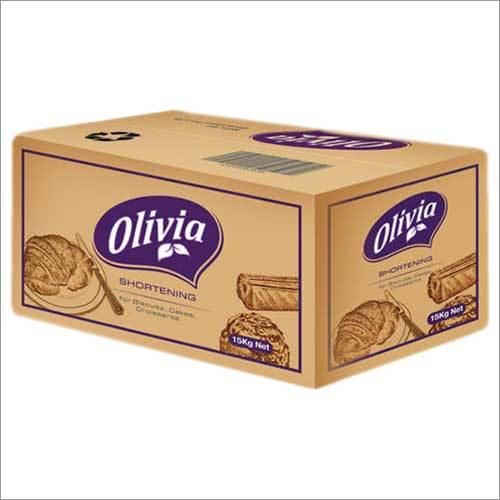

Vegetable Shortening
20 USD ($)/Metric Ton
Product Details:
- Grade Food
- Product Name Vegetable shortening
- Feature Healthy Product
- Packaging Box
- Usage Cooking
- Click to View more
X
Vegetable Shortening Price And Quantity
- 22 Metric Ton
- 20 USD ($)/Metric Ton
Vegetable Shortening Product Specifications
- Vegetable shortening
- Cooking
- Box
- Healthy Product
- Food
Vegetable Shortening Trade Information
- 4-5 Days
- All India
Product Description
Vegetable Shortening primary usage is to abbreviate baked goods like pastry and pie crusts to produce a finished product that is supple and flaky. This is achieved by preventing the cohesiveness of wheat gluten strands during mixing. In particular for baking, it is used in place of butter or lard. Vegetable Shortening can help make pie crust flaky, produce more stable icings and frostings, and prevent cookies from spreading excessively when baking. Shortening is a solid fat created by hydrogenating vegetable oil; it has almost no flavor or odor.
Vegetable shortening is a type of solid fat made from vegetable oils, usually containing hydrogenated or partially hydrogenated oils. It is commonly used in baking and cooking to add fat and improve the texture of various dishes. Here are some typical uses for vegetable shortening:
1. Baking:
- Pie crusts: Vegetable shortening is often used in pie crust recipes to create a flaky and tender texture.
- Biscuits and scones: It helps to create a light and tender crumb in these baked goods.
- Cakes: Vegetable shortening can be used as a substitute for butter or oil in cake recipes.
- Cookies: Some cookie recipes call for vegetable shortening to achieve a specific texture.
2. Frying:
Vegetable shortening can be used as a frying medium for items like donuts, churros, and certain types of fried dough.
3. Non-stick coating:
Greasing pans and baking sheets: Vegetable shortening can be used to grease baking pans to prevent sticking.
4. Shelf life extension:
In some recipes, vegetable shortening can help extend the shelf life of certain products, like homemade icings or frostings.
When using vegetable shortening, keep the following tips in mind:
- Measurement: Measure the vegetable shortening accurately using dry measuring cups or weighing scales, as its solid form can make it difficult to eyeball the right amount.
- Substitution: Vegetable shortening can be substituted with butter or margarine in some recipes, but keep in mind that it may alter the texture and flavor.
- Storage: Store vegetable shortening in a cool, dry place away from direct sunlight. It has a long shelf life, but it can go rancid over time, so check for any off odors before using.
- Health considerations: While vegetable shortening is commonly used, it's essential to note that it contains trans fats, which are considered unhealthy when consumed in large amounts. As such, it's generally recommended to limit the intake of trans fats in the diet.
FAQ:
Q. What is vegetable shortening?
Ans: Vegetable shortening is a type of solid fat made from vegetable oils, usually through a process of hydrogenation or partial hydrogenation. It is used as a cooking and baking ingredient to add fat and improve the texture of various dishes.
Q. What is the difference between vegetable shortening and butter?
Ans: The primary difference between vegetable shortening and butter is their composition. Vegetable shortening is made from vegetable oils, while butter is made from cream. Vegetable shortening is 100% fat, while butter contains water and milk solids. In baking, shortening tends to create a crisper texture, while butter adds a rich flavor.
Q. Can I use vegetable shortening instead of butter in baking?
Ans: Yes, vegetable shortening can often be used as a substitute for butter in baking. However, keep in mind that it may affect the texture and flavor of the final product. For example, cookies made with shortening tend to be more tender and have a lighter texture compared to cookies made with butter.
Q. Is vegetable shortening the same as lard?
Ans: No, vegetable shortening and lard are different. While both are solid fats used in baking and cooking, vegetable shortening is made from vegetable oils, and lard is made from rendered pork fat. They have distinct flavors and properties, so they are not always interchangeable in recipes.
Q. Can I use vegetable shortening for frying?
Ans: Yes, vegetable shortening can be used for frying. It has a high smoke point, making it suitable for deep-frying certain foods like donuts and other pastries. However, other fats like vegetable oil, canola oil, or peanut oil are more commonly used for frying due to their neutral flavors.
Q. How should I store vegetable shortening?
Ans: Store vegetable shortening in a cool, dry place away from direct sunlight. It is best kept in its original container with a tightly sealed lid. Proper storage will help extend its shelf life.
Q. Is vegetable shortening a healthy option?
Ans: Vegetable shortening contains trans fats, which are considered unhealthy when consumed in large amounts. Trans fats can raise bad cholesterol levels and increase the risk of heart disease. As a result, it is generally recommended to limit the intake of trans fats in the diet. Alternatives like unsaturated fats (e.g., vegetable oils) are considered healthier choices.
Q. Can I use vegetable shortening to make icing or frosting?
Ans: Yes, vegetable shortening can be used to make icing or frosting. It can create a stable and smooth texture in frostings, especially in recipes where a solid fat is preferred over a liquid one.
Enter Buying Requirement Details
 English
English Spanish
Spanish French
French German
German Italian
Italian Chinese (Simplified)
Chinese (Simplified) Japanese
Japanese Korean
Korean Arabic
Arabic Portuguese
Portuguese





